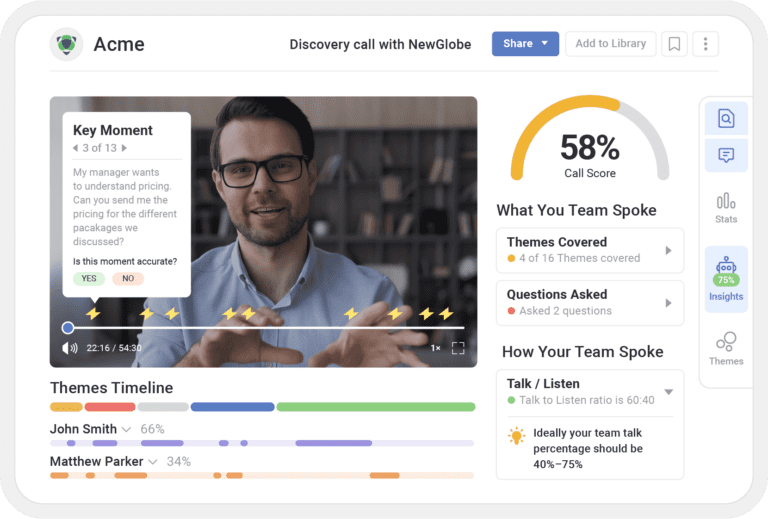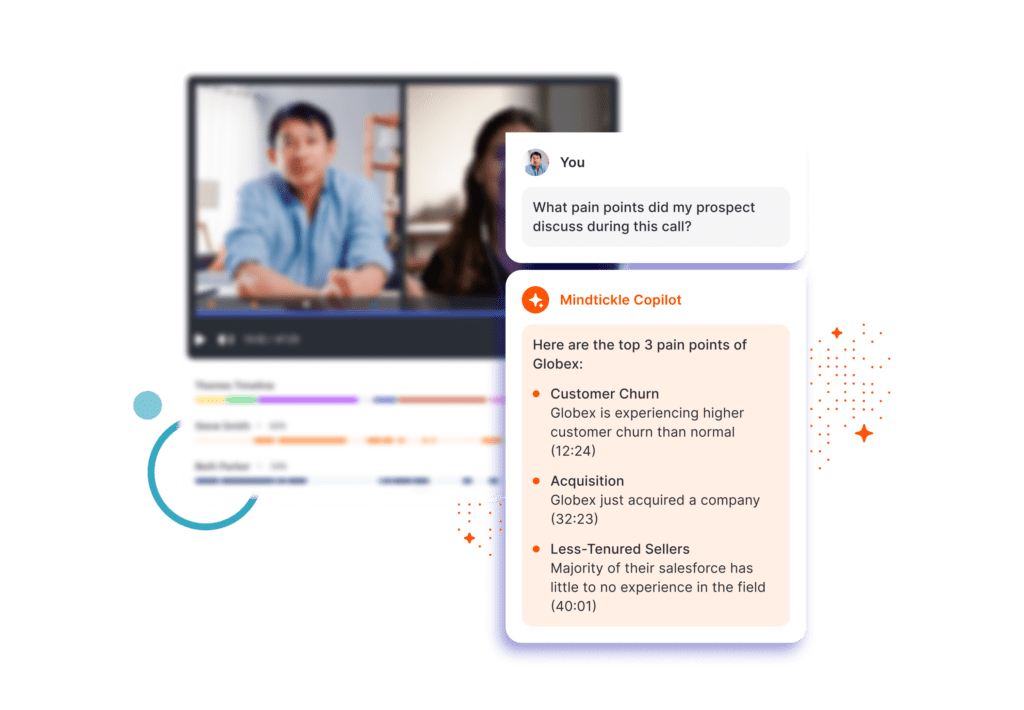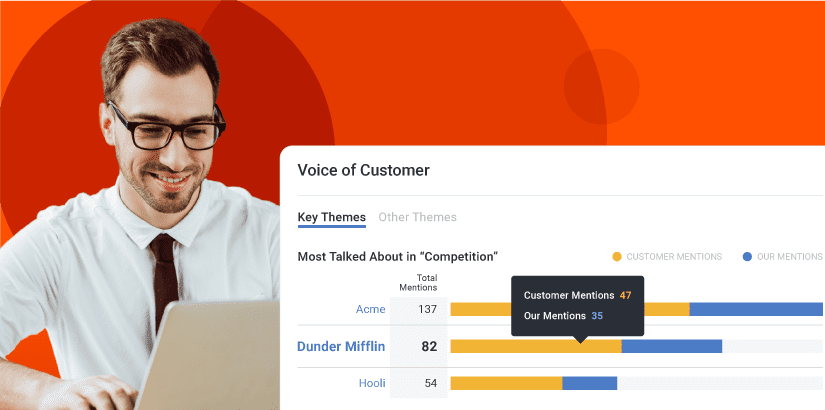How to Analyze Sales Call Recordings to Uncover Valuable Customer Feedback
![]() Rahul Mathew
on
October 7, 2024
Rahul Mathew
on
October 7, 2024
In the past, a seller relied on their memory and their messily scrawled notes to recall what happened during a sales call and determine what steps to take next. Today, many organizations use conversation intelligence tools to record, analyze, and share sales calls.
Call recordings are an invaluable way to unlock insights from customers and prospects. Sharing these calls amongst the team encourages collaboration and promotes best practices.
Last year, nearly half a million sales calls were recorded using Mindtickle’s conversation intelligence feature. But how do winning revenue organizations use these sales calls to improve performance and close more deals?
Last year nearly
In this post, we’ll discuss why sales call recordings are important and how you can start analyzing them to uncover valuable customer feedback and maximize sales performance across your entire team.
Call recordings reveal the “why” behind customer decisions
Knowing the “why” behind the customer’s decision is critical. Did sellers fail to articulate the value of your solution? Did the messaging miss the mark? Was another vendor’s pricing more competitive? Did the seller lack the competitive intelligence to address the customer’s questions or objections adequately?
Not understanding the wants, needs, concerns, and expectations of buyers and lacking insight into the customer experience during sales calls can have dire consequences for your business, including:
- Deals are lost to better-prepared competitors
- Key business initiatives – competitive and market strategies, sales methodologies, etc. – fail too frequently
- Best practices are difficult to identify, share, or replicate
- Outdated messaging affects deal outcomes
- Fewer reps make quota
- Churn increases
- Your company misses revenue targets
Sales organizations can automatically capture and transcribe live sales conversations using conversation intelligence and call recording tools to reveal the “why” behind wins and losses. Your sales managers get access to invaluable insights about your customers and their interactions with your sales teams so you can better understand:
- How customers perceive your brand
- What they think about your solution and its value
- How they view the competition
- What objections they have
- Why a deal may be in jeopardy
- What more they expect from your company

Call recordings uncover sales training and coaching opportunities
AI-driven analysis of sales call recordings can reveal a seller’s strengths and weaknesses, as well as trends such as the talk-to-listen ratio, the frequency of objections or how often customers mention a specific competitor across all calls. Your sales managers can identify areas for improvement by digging into high points or shortcomings during conversations. They can understand the topics and themes discussed and the overall impact of the interaction.
Then, using these data-driven insights, your managers can diagnose conversations, identify personalized sales coaching opportunities, implement best practices across your teams, and ensure sales methodologies and training align with the needs and expectations of the buyers in your market.
How to create a customer feedback loop to improve your go-to-market strategy
Analyzing call recordings can deliver actionable insights that extend across the organization. To ensure ongoing alignment and to optimize your organization’s go-to-market strategy, you can use call recordings to establish a strong feedback loop across sales, customer success, and marketing.
Most sellers want feedback on their performance but are hesitant to ask for it. On top of that, most feedback from sales managers is anecdotal and not based on any objective assessment. An effective feedback loop incorporates insights from call recordings and enables managers to identify and close gaps in knowledge and skills.
Managers can provide direct feedback to individual sellers by commenting on specific recording snippets – offering critiques, comments, or advice. Using insights gleaned from call recordings, managers can recommend or request specific coaching and sales training opportunities to address competency or skill gaps and then continue to analyze future customer calls to gauge performance improvements.
The majority of sellers want to know your top rep’s secret sauce. They’re seeking inspiration and guidance on creative ways to position and address questions. Using call recordings, managers can share best practices from key snippets to motivate sellers and inform ongoing training. For example, during sales onboarding, new hires can review recordings and snippets from the best sales conversations and then practice through role-play so managers or other team members can offer qualitative and quantitative feedback submitted by new sales reps.
Call recordings can ensure nothing gets lost in translation between sellers and customer success teams. Sellers can share account history, information, and updates to execute a seamless handoff. Customer success teams can share recordings, snippets, and information with sellers if they identify new issues or opportunities within an account.
Call recordings give marketing direct insight into the voice of the customer, providing an insider’s view of buyer pain points and challenges. Marketing teams can team create, campaigns and messaging that speak directly to customer needs. Call recordings may uncover that current positioning is not resonating with customers or differentiated enough from the competition.
Customers are telling you what they think; you just need to listen
Some leaders might be unsure about call recordings because they don’t want to come across as intrusive. The value of analyzing call recordings isn’t to spy on buyers or sellers, but to reveal direct, actionable insights into the buyers in your market – their wants, needs, perceptions, and objections.
It’s also important to remember that the most successful reps have a growth mindset. They don’t let embarrassment or insecurity get in the way of their professional growth. Call recordings help identify sellers’ strengths and weaknesses so managers can give them advice, feedback, training, and tools to help them succeed.
Call recordings help pinpoint what’s working and what’s not, establishing a continuous feedback loop between sales, customer success, and marketing to ensure ongoing visibility and continuous improvement. Using insights gleaned from the voice of your customers gives your organization a significant competitive edge:
- Sellers are empowered to win against more poorly prepared competitors
- Key business initiatives are far more likely to succeed because they’re informed by critical field-based evidence
- Best practices are easy to identify, share, and replicate
- Marketing can craft messaging that aligns with buyer needs
- More sellers will make or exceed quota
- Your organization will meet or exceed revenue targets
Best practices for analyzing and using sales call recordings
Recording and analyzing sales calls can help teams uncover insights that can be used to improve customer experiences and sales performance. There are a few best practices to keep in mind.
Choose the right call recording tool
Several software solutions are available that offer the ability to record sales calls. Be sure to define your goals for recording sales calls – and then find a solution offering features and functionality to help you achieve those goals. Reading peer reviews on a site like G2 can provide insight into what customers like (and don’t like) about any solutions you’re considering.
Leverage AI to analyze sales calls
Recording your sales calls doesn’t provide much value if you don’t do anything with the recordings. But analyzing sales calls requires a lot of time and effort.
Look for ways to leverage AI like Mindtickle’s Copilot to effectively and efficiently analyze your sales calls. For example, AI can summarize call recordings and help you pinpoint key moments in a call. A sales rep can use AI to ask a question like, “Which competitors did my customer bring up on this call?” Then, the sales reps can use these insights to tailor their follow-up and combat objections.

Deliver instant feedback to sellers
Today, some conversation intelligence tools provide a score and feedback immediately after each sales call. For example, the tool might provide feedback on things like use of filler words, longest monologue, sentiment, and number of questions asked and answered. Sellers can use this real-time feedback to sharpen their skills and improve the outcome of a deal.
Share insights cross-functionally
Per our 2024 State of Revenue Productivity Report, 25% of calls are shared across the organization. That makes sense, as sales call insights can benefit many teams.
For example, sales managers can use call insights to understand where their sellers are (and aren’t) excelling. This can inform training and sales coaching opportunities. Marketing teams can use call recordings to access voice of the customer insights, which can help them develop more effective campaigns.
Be sure your call recording or conversation intelligence tools make it easy to share calls so different individuals and teams can benefit from the insights.
Provide proper training
When rolling out any new tool or technology, providing proper training is important. Rolling out a call recording tool is no exception.
Be sure your revenue teams know how you use your conversation intelligence tool and how to access and use insights to improve skills and sales outcomes.
Tap into your sales call recordings and start closing more deals
Sales call recordings provide insights for improving customer experiences and sales performance. But simply recording your sales calls isn’t enough.
Instead, you must analyze your sales calls to understand what’s really happening in the field and turn those insights into action. The right conversation intelligence tool is a must.
Conversation Intelligence in Mindtickle
Learn more about conversation intelligence and how Mindtickle's Call AI is helping other organizations get actionable data from customer calls.
Request a DemoThis post was originally published in May 2021, updated in July 2023, January 2024, and again in October 2024.


